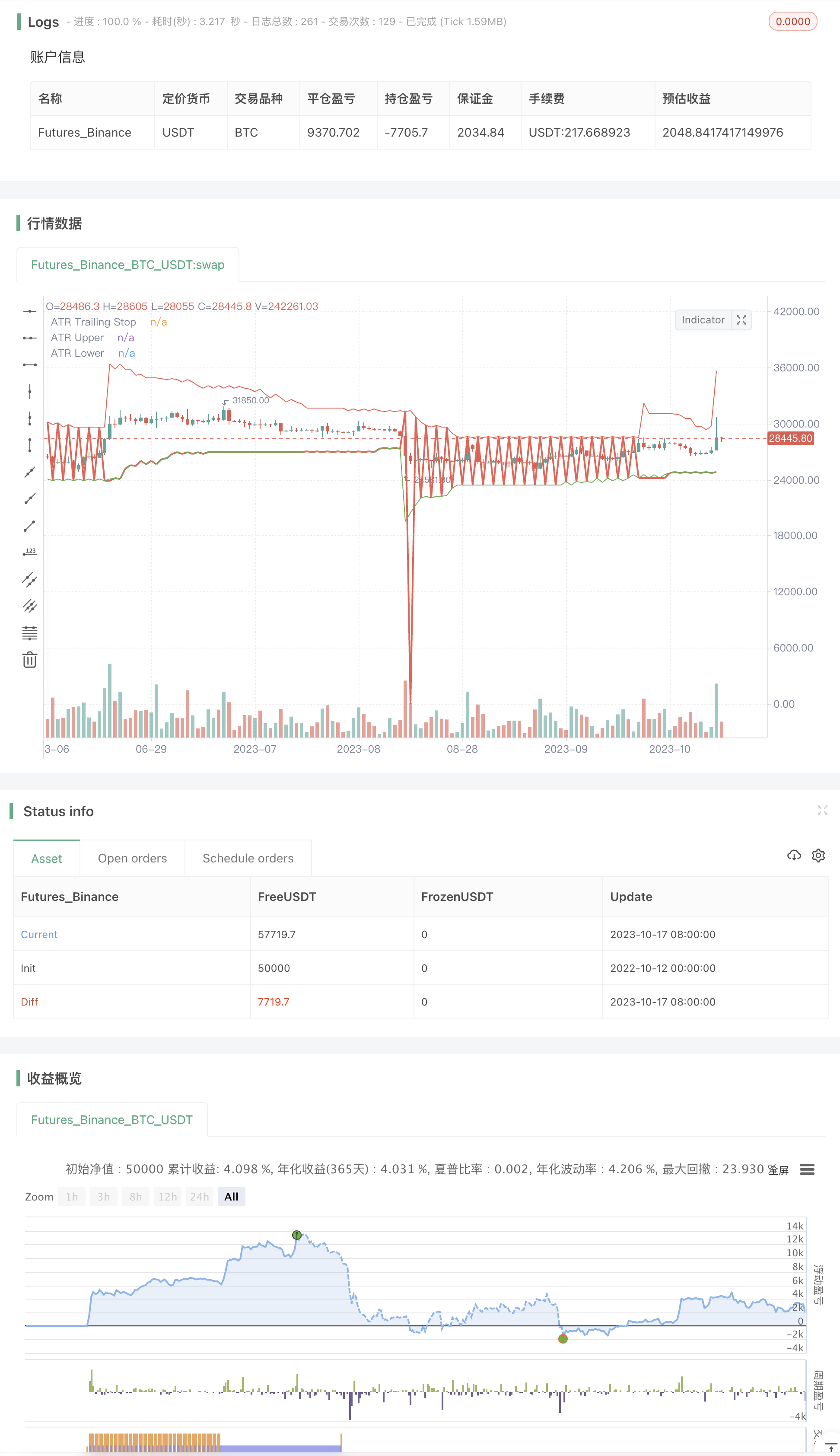
概述
本策略的核心思想是利用平均真实波幅(ATR)指标来设定一个自适应的跟踪止损线,让获利的头寸得到最大程度的保护,同时避免过早止损。ATR指标能够动态捕捉市场的波动程度,根据市场波动调整止损距离,在保证止损的同时尽量减少止损被触发的概率。本策略同时加入布林带,可视化止损线的上下限,并可选择是否加入影线保护来抵御震荡市的影响。
策略原理
本策略使用ATR指标的N周期平均值乘以一个倍数作为基础止损距离。ATR值越大,表示市场波动越大,止损距离就设定的越宽;ATR值越小,止损距离就设定的越窄。这样可根据市场波动程度动态调整止损距离。
具体来说,策略使用以下核心逻辑:
计算ATR周期(nATRPeriod)的ATR值。
根据ATR值乘以倍数(nATRMultip)得到基础止损距离nLoss。
根据当前高点、低点和上一周期的止损线更新止损线xATRTrailingStop。
如果当前低点触发了上一周期止损线,则止损线上移至低点以下nLoss的距离。
如果当前高点触发了上一周期止损线,则止损线下移至高点以上nLoss的距离。
如果未触发止损,则根据收盘价离止损线的距离调整止损线。
加入可选的影线保护距离,进一步优化止损线。
绘制布林带轨道来可视化止损线的上下限。
根据止损线颜色判定持仓方向。
该策略灵活运用ATR指标,让止损线能够根据市场波动自适应调整,既可确保止损距离合理,也可尽量避免过于激进的止损造成不必要的头寸损失。
优势分析
本策略具有以下优势:
利用ATR指标动态调整止损距离,能够自适应不同市况。
倍数参数可自定义,实现止损距离的灵活调整。
加入布林带轨道,形成止损线的可视化上下限。
可选影线保护功能,避免震荡市的whipsaw。
可作为跟踪止损使用,让获利头寸最大限度回撤。
策略思路清晰易懂,参数少易优化。
可在多种品种和周期使用,适用面较广。
风险分析
本策略也存在一些风险需要注意:
ATR指标对市场突发事件反应滞后,可能导致止损距离过大。
倍数设置过大也会导致止损距离过宽,增加亏损风险。
影线保护功能在震荡增大时会使止损线过于宽松。
未考虑进场规则,不能作为 Entries/Exits 策略。
需反复测试优化参数,适应不同品种和周期。
突破止损可能导致亏损扩大,需要有效的资金管理。
优化方向
本策略可从以下几个方面进行优化:
测试不同的ATR周期参数,优化止损距离。
调整倍数参数,在止损距离和止损概率间找到平衡。
优化影线保护周期参数,防止 whipsaw。
尝试在止损基础上加入入场条件,使之成为 Entries/Exits 策略。
加入趋势判断指标,根据趋势调整止损距离。
结合波浪理论,根据波浪位置调整止损距离。
加入仓位控制,限制单笔损失。
总结
本策略利用ATR指标的自适应特性,设计了一个能够动态调整的止损机制。在保证止损的同时,也尽可能减少不必要的止损触发。策略思路简单清晰,可根据自身需要进行灵活优化。作为跟踪止损工具使用效果更佳,可最大限度保护头寸获利。在参数优化和风险控制到位的情况下,本策略可以成为量化交易中的一个有效止损工具。
/*backtest
start: 2022-10-12 00:00:00
end: 2023-10-18 00:00:00
period: 1d
basePeriod: 1h
exchanges: [{"eid":"Futures_Binance","currency":"BTC_USDT"}]
*/
//@version=2
////////////////////////////////////////////////////////////
// Copyright by HPotter v2.0 13/10/2014
// Average True Range Trailing Stops Strategy, by Sylvain Vervoort
// The related article is copyrighted material from Stocks & Commodities Jun 2009
// Modified by River to add Bands, and change color of Trailing Stop and add Wick Protection. Now turned into a Strategy for Backtesting Purposes.
// After backtesting, it seems clear that it functions well as a Trailing Stop, but not as an Entry/Exit strategy.
////////////////////////////////////////////////////////////
strategy(title="ATR Trailing Stop Bands Strategy[R] ", overlay = true)
nATRPeriod = input(5)
nATRMultip = input(4)
length = input(30, "#Periods of Wick Protection", minval=2)
bType = input(0, "Max [1] or Avg Wick Protection [0]", minval=0, maxval=1)
avgupperwick = sma(close[1] <= open[1] ? high[1] - open[1] : high[1] - close[1], length)
maxupperwick = highest(close[1] <= open[1] ? high[1] - open[1] : high[1] - close[1], length)
avglowerwick = sma(close[1] > open[1] ? open[1] - low[1] : close[1] - low[1], length)
maxlowerwick = highest(close[1] > open[1] ? open[1] - low[1] : close[1] - low[1], length)
upperwick = bType == 0 ? avgupperwick : maxupperwick
lowerwick = bType == 0 ? avglowerwick : maxlowerwick
xATR = atr(nATRPeriod)
nLoss = nATRMultip * xATR
upperband = iff(high < nz(upperband[1], 0) and high[1] < nz(upperband[1], 0), min(nz(upperband[1]), high + nLoss + upperwick), high + nLoss + upperwick)
lowerband = iff(low > nz(lowerband[1], 0) and low[1] > nz(lowerband[1], 0), max(nz(lowerband[1]), low - nLoss - lowerwick), low - nLoss - lowerwick)
xATRTrailingStop = iff(low > nz(xATRTrailingStop[1], 0) and low[1] > nz(xATRTrailingStop[1], 0), max(nz(xATRTrailingStop[1]), low - nLoss - lowerwick),
iff(high < nz(xATRTrailingStop[1], 0) and high[1] < nz(xATRTrailingStop[1], 0), min(nz(xATRTrailingStop[1]), high + nLoss + upperwick),
// iff(low <= nz(xATRTrailingStop[1], 0) and close[1] > nz(xATRTrailingStop[1], 0), high + nLoss + upperwick, iff(high >= nz(xATRTrailingStop[1], 0) and close[1] < nz(xATRTrailingStop[1], 0), low - nLoss - lowerwick,0))))
iff(low <= nz(xATRTrailingStop[1], 0) and close[1] > nz(xATRTrailingStop[1], 0), upperband[1], iff(high >= nz(xATRTrailingStop[1], 0) and close[1] < nz(xATRTrailingStop[1], 0), lowerband[1],0))))
pos = iff(close[1] > nz(xATRTrailingStop[1], 0) and low <= nz(xATRTrailingStop[1], 0), 1,
iff(close[1] < nz(xATRTrailingStop[1], 0) and high >= nz(xATRTrailingStop[1], 0), -1, nz(pos[1], 0)))
color = pos == 1 ? red: pos == -1 ? green : blue
plot(upperband, color=red, title="ATR Upper")
plot(xATRTrailingStop, color=color, title="ATR Trailing Stop", linewidth=2)
plot(lowerband, color=green, title="ATR Lower")
longCondition = (color == green and color[1] == red)
if (longCondition)
strategy.entry("Long", strategy.long)
longExitCondition = (color == red and color[1] == green)
if (longExitCondition)
strategy.close("Long")
shortCondition = (color == red and color[1] == green)
if (shortCondition)
strategy.entry("Short", strategy.short)
shortexitCondition = (color == green and color[1] == red)
if (shortexitCondition)
strategy.close("Short")